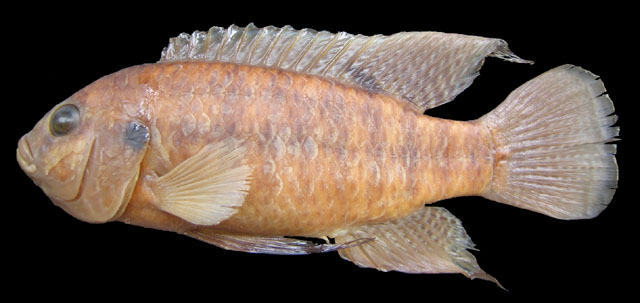| Cichlidae (Cichlids), subfamily: Pseudocrenilabrinae |
| 10.4 cm TL (male/unsexed) |
|
benthopelagic; freshwater |
| Africa: swampy high plateaus of the Congo-Zambezi watershed (Ref. 5163), including the Kasai system (Ref. 120641), Lufira River (Ref. 82322), Lake Mweru (Ref. 82564) and the Luongo (Luapula tributary)(Ref. 27609). Also known from the Okavango delta (Ref. 7248) and (upper) Zambezi (Ref. 11970, 120641). Reported from Zimbabwe (Ref. 13337). |
|
Description: body ovoid and moderately slender; some rays in pelvic, dorsal and anal fins may be fairly elongated; frontal profile straight; caudal fin slightly rounded (Ref. 52307).
Coloration: body grayish-brown to brown, with some vertical dark bars or a longitudinal stripe, depending on behavioral situation; unpaired fins usually with numerous pale small spots (Ref. 52307). |
| Occurs in swamps and floodplain habitats, especially enriched pans and well-vegetated shallow littoral margins of drainage rivers. Feeds on detritus, soft plants and insect larvae. Males establish a territory and attract a ripe female to form a pair bond. Females construct a saucer-shaped nest in which eggs are laid and fertilized then tended mainly by the female while the male guards the territory (Ref. 7248). |
|
Least Concern (LC); Date assessed: 01 May 2009 Ref. (130435)
|
| harmless |
|
Source and more info: www.fishbase.org. For personal, classroom, and other internal use only. Not for publication.

